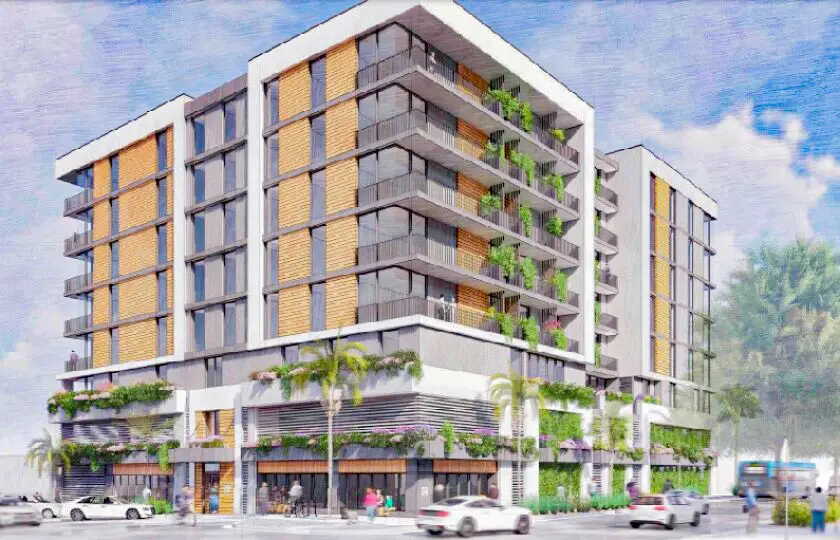OCEANSIDE — After failing to set a new limit on downtown housing density last week, the City Council will again discuss potentially capping residential developments between 85 and 100 units per acre later this month.
In 2019, the council changed its downtown density cap from 43 units per acre to unlimited density. The change, in combination with the state’s density bonus law, led to development projects far denser than anticipated, such as the 712 Seagaze project, an eight-story development with 115 studio apartments and 64 hotel rooms on a 0.36-acre lot downtown.
According to Manuel Baeza, a principal planner with the city, the Seagaze project created a density of about 321 units per acre.
“Changes to the state density bonus law limited the city’s ability to apply development standards (building height, setbacks, parking) without penalties, thereby enabling such high-density projects with multiple code waivers,” Baeza told the City Council on Oct. 4.
As a remedy, staff proposed to set a new cap at 100 units per acre for mixed-use projects downtown. To incentivize developers to build more affordable housing, staff also recommended allowing a 75% density bonus on top of that 100-unit limit if they include 15% affordable housing for very low-income households or 20% low-income and a 35% density bonus at 30% moderate income.
According to City Planner Sergio Madera, if the staff’s suggestion was approved, downtown projects could exceed 200 units if developers invoke the maximum density bonus allowed.
Under the state’s density bonus law, a developer is permitted to build 50% more units than would otherwise be allowed if at least 15% of units under the base density are reserved for very low-income, 24% for low-income, or 44% for moderate-income. Density bonus projects are generally between 35% and 50%.

While Councilmember Eric Joyce acknowledged staff made a “worthy effort” to address the rapidly increasing density downtown, he felt the 100-unit cap was a 200-unit cap in disguise that added far more above-market rate homes than affordable housing.
“The redundancy is we’re saying we’re getting 25% affordable units but doubling the market rate units, so it’s not really 25% affordability,” Joyce said.
For Joyce, going with the city’s inclusionary housing requirement – which currently requires developers to include 10% affordable units in a project and will soon bump up to 15% – would be a better deal, leading to more affordable housing with smaller, less dense projects. These projects still invoke the state’s density bonus law, adding more market-rate units.
Joyce originally suggested bumping the cap to 75 units per acre before amending it to 85 units instead. He intended to ensure downtown developments wouldn’t exceed 150 units per acre under density bonus.
“We need smart and reasonable housing,” Joyce said.
Deputy Mayor Ryan Keim disagreed with Joyce’s reasoning, explaining that developers need to add more market-rate units to compensate for the money lost in building affordable units.
“Affordable housing is not free,” Keim said. “All that stuff costs money. If we’re going to provide affordable housing, there has to be density. I’m fine with not having affordable housing in the coastal zone, but we have to realize that with what you’re proposing we’re not going to get affordable housing downtown… it’s easy to come up here and have these ideas and say we want affordable housing but we want to fit the neighborhood scale. At a certain point, we’ve got to pick one or the other.”
Joyce’s motion to set an 85-unit cap, striking staff’s suggested incentives, died for lack of a second. Councilmember Peter Weiss’s motion to establish an 85-unit cap with the incentives failed following a 2-2 vote, with Weiss and Councilmember Rick Robinson in favor and Joyce and Keim opposed.
Mayor Esther Sanchez was absent from the meeting due to an illness.
The council will resume discussion on the density cap in downtown on Oct. 18, per city code.


